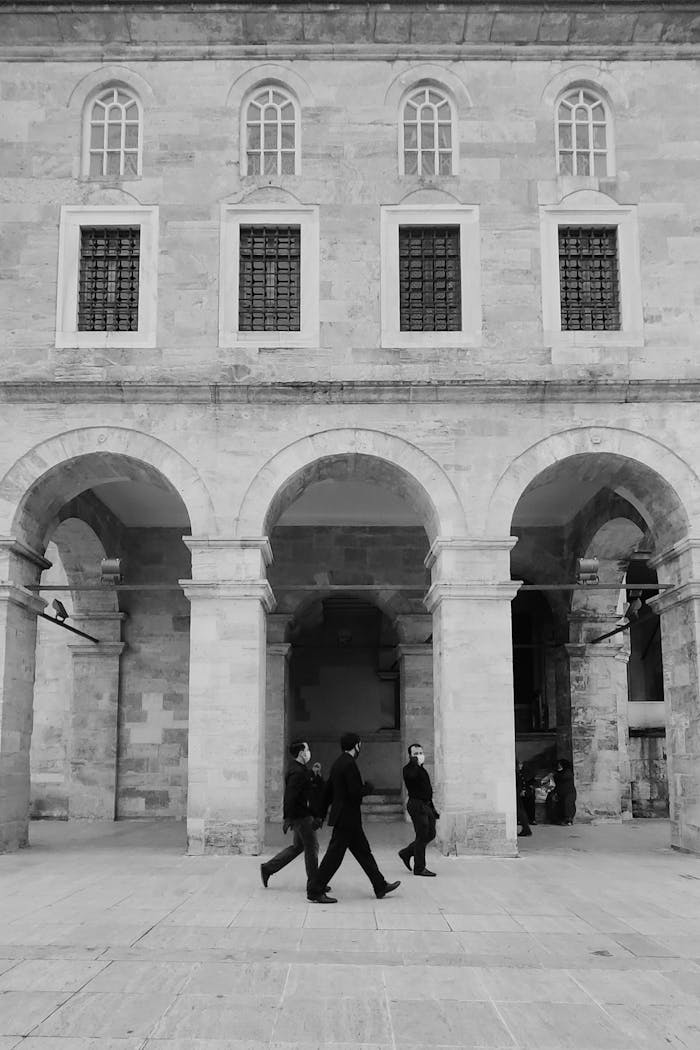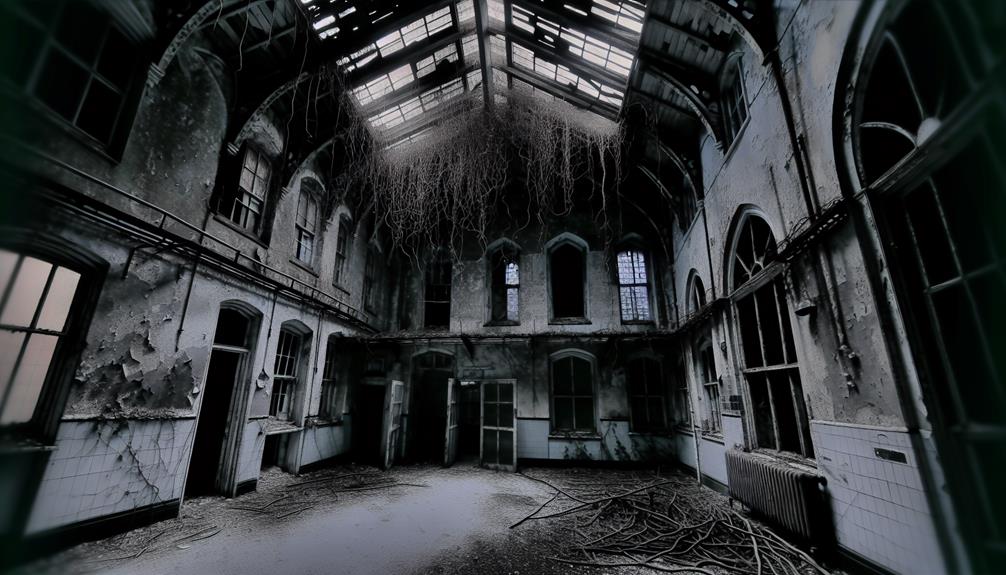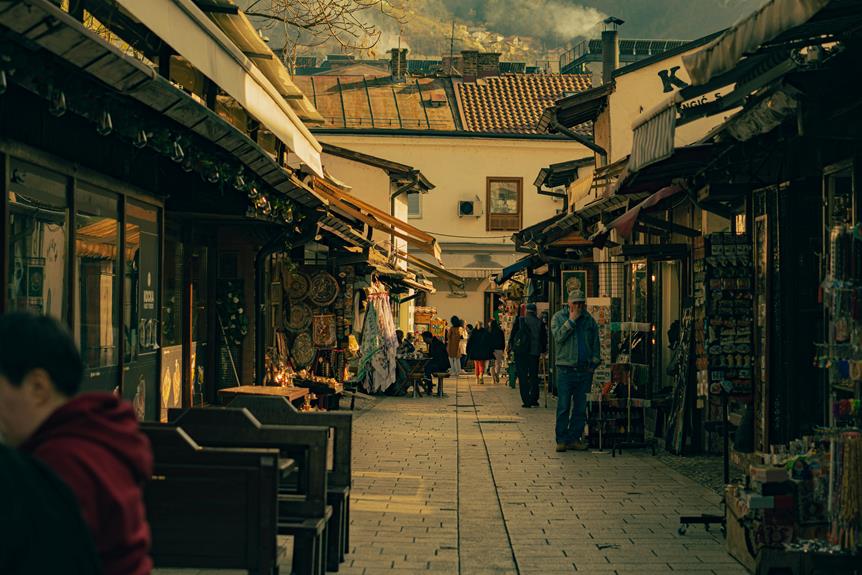The haunting legacy of Jasenovac, Croatia's infamous concentration camp, elicits somber reflections on a dark chapter in human history. As we peer into the depths of this harrowing past, the shadows cast by unspeakable atrocities beckon us to confront the unfathomable depths of human cruelty. Within its barbed wire confines, the voices of the victims echo through time, urging us to remember, to learn, to confront uncomfortable truths. In exploring the layers of horror and resilience intertwined within Jasenovac's history, we are compelled to grapple with the weight of remembrance and the imperative of preserving the lessons etched in its blood-stained walls.
Key Takeaways
- Jasenovac tied to Croatia's genocidal policies in WWII.
- Among Europe's largest and brutal camps targeting various ethnic groups.
- Atrocities included mass shootings, beatings, and specialized killing methods.
- Notorious commanders like Miloš and Šakić oversaw heinous acts.
- Importance of education and remembrance to prevent future atrocities.
Origins of Jasenovac
The inception of Jasenovac as a concentration camp can be traced back to the establishment of the Independent State of Croatia in 1941. Following the Axis invasion of Yugoslavia, the Ustasha regime, led by Ante Pavelic, collaborated closely with Nazi Germany. The Ustasha regime, characterized by its extreme nationalism and radical ideologies, sought to create a racially pure Croatian state.
As part of this vision, the Ustasha authorities established Jasenovac as a concentration camp in August 1941. Situated along the Sava River in Croatia, Jasenovac was one of the largest and most brutal camps in Europe. The formation of Jasenovac was intricately tied to the Ustasha's genocidal policies, aiming to exterminate not only Jews but also Serbs, Roma, and anti-fascist Croats.
Under the guise of creating a 'Croatian homeland,' the Ustasha regime perpetrated unspeakable atrocities at Jasenovac. The camp consisted of several complexes where prisoners endured forced labor, starvation, torture, and mass executions. The scale of violence and the systematic nature of the killings underscore the extent of Nazi collaboration and the brutality of the Ustasha regime.
In essence, the formation of Jasenovac epitomizes the dark legacy of collaboration with Nazi forces and the horrors brought about by extremist ideologies. The camp's origins showcase the depths of human depravity and serve as a stark reminder of the atrocities committed during World War II.
Establishment and Structure
Jasenovac's establishment and structure as a concentration camp were meticulously designed to facilitate the Ustasha regime's genocidal policies and perpetration of atrocities against its prisoners. The camp was constructed using various methods, with different areas serving specific purposes within the overall system. One key aspect of Jasenovac was the establishment of a strict prisoner hierarchy, where inmates were categorized based on ethnicity, religion, and perceived threat to the Ustasha regime. This hierarchy played a significant role in determining the fate of the prisoners and the level of brutality they would endure.
| Construction Methods | Purpose | Significance |
|---|---|---|
| Labor-intensive | Building infrastructure | Exploitation of prisoners' physical labor |
| Barbed wire fences | Security | Preventing escape and enforcing control |
| Guard towers | Surveillance | Monitoring prisoners and preventing revolt |
The camp's structure consisted of barracks, administrative buildings, guard towers, and a network of barbed wire fences, all strategically positioned to maintain order and control over the inmates. The use of labor-intensive construction methods not only served to expand the camp but also subjected the prisoners to harsh conditions and grueling work. The presence of guard towers and barbed wire fences emphasized the high level of security and surveillance, highlighting the oppressive environment in which the inmates were held. The careful planning and execution of Jasenovac's establishment and structure underscore the systematic nature of the atrocities committed within its walls.
Inhumane Living Conditions
With deplorable sanitation facilities and overcrowded living quarters, inmates at the concentration camp in Jasenovac endured unimaginable hardship on a daily basis. The living conditions in Jasenovac were designed to dehumanize and break the spirits of the prisoners. The lack of proper sanitation led to the spread of diseases like typhus, dysentery, and tuberculosis, causing immense suffering and death among the inmates. The overcrowded barracks meant that individuals had minimal personal space, slept in cramped conditions, and had to endure extreme temperatures without adequate clothing or bedding.
The impact on survivors of Jasenovac was profound, with many experiencing long-lasting psychological trauma as a result of their time in the camp. The constant fear, violence, and humiliation inflicted on the prisoners left deep emotional scars that persisted long after their liberation. Survivors often struggled with feelings of guilt, shame, and survivor's guilt, haunted by the memories of the atrocities they witnessed and endured. Many survivors faced difficulties reintegrating into society post-liberation, as they grappled with the physical and psychological wounds inflicted during their time in Jasenovac.
The inhumane living conditions at Jasenovac not only physically weakened the prisoners but also shattered their mental and emotional well-being, leaving a lasting legacy of trauma that continues to affect survivors and their families to this day.
Systematic Genocide
Amidst the horrors of Jasenovac concentration camp, the systematic genocide orchestrated by the Ustaše regime targeted specific ethnic and religious groups with chilling efficiency. Impactful remembrance of this dark chapter in history sheds light on the historical significance of the atrocities committed at Jasenovac.
The genocide at Jasenovac was marked by several key features:
- Ethnic Targeting: The Ustaše regime specifically targeted Serbs, Jews, Roma, and anti-fascist Croats for extermination. This deliberate selection of victim groups exemplified the regime's intent to eradicate those deemed undesirable.
- Brutal Methods: The systematic genocide at Jasenovac employed brutal methods such as mass shootings, beatings, stabbings, and the use of specialized killing tools like knives and hammers. This brutality aimed to instill fear and maintain control over the prisoners.
- Dehumanization: Victims at Jasenovac were dehumanized through forced labor, starvation, and humiliation. Deprived of basic necessities and subjected to constant degradation, the prisoners endured a loss of identity and dignity.
- Efficiency and Scale: The Ustaše regime's systematic approach to genocide at Jasenovac resulted in the extermination of tens of thousands of individuals. The efficient operation of the camp, with its network of killing sites and crematoria, enabled the rapid and widespread implementation of the genocide.
Notorious Camp Commanders
Notable for their ruthless enforcement of the Ustaš̌e regime's genocidal policies, the commanders of Jasenovac concentration camp played pivotal roles in orchestrating and overseeing the atrocities committed within its confines. Among the most infamous figures was Ljubo Miloš, who served as the commandant of Jasenovac from February 1942 to August 1944. Miloš was known for his brutal leadership, actively participating in the torture and killing of prisoners. His sadistic methods contributed to the camp's reputation as one of the most brutal in Europe during World War II.
Another key figure was Petar Brzica, a Croatian Ustaš̌e war criminal who served as a guard and executioner at Jasenovac. Brzica gained notoriety for boasting about the speed at which he could kill inmates with a knife, earning him the nickname 'the knife man.' His actions symbolize the extreme cruelty exhibited by those in charge of the camp.
These commanders, along with others like Ivica Matković and Dinko Šakić, were responsible for implementing the Ustaš̌e regime's genocidal policies, leading to the deaths of thousands of innocent people. Their brutal leadership and participation in heinous acts solidify their places in history as war criminals who perpetuated unimaginable suffering within the walls of Jasenovac.
Resistance and Escapes
Resistance to the brutal regime at Jasenovac and daring escapes from the camp's confines underscored the unwavering spirit and determination of those held captive during this dark period of history. Despite the extreme conditions and constant fear, prisoners at Jasenovac exhibited remarkable acts of resistance and bravery in their quest for freedom.
- Organized Uprisings:
Prisoners at Jasenovac staged several organized uprisings to protest against the cruel treatment and inhumane conditions. These acts of resistance were a symbol of their refusal to submit to the oppressive regime.
- Sabotage and Acts of Defiance:
In addition to organized uprisings, inmates engaged in acts of sabotage and defiance to disrupt the camp's operations and resist the authorities. These small acts of rebellion were significant displays of resistance.
- Collaborative Escape Attempts:
Despite the high level of surveillance and security measures, prisoners collaborated on daring escape plans. These escape attempts required careful planning and coordination among the inmates to evade capture and seek freedom.
- Risking Everything for Freedom:
The daring escapes from Jasenovac were a demonstration of the prisoners' unwavering determination to regain their freedom, even in the face of almost certain death. These courageous acts highlighted the resilience and strength of the human spirit in the most challenging of circumstances.
In the face of unimaginable horrors, the resistance efforts and daring escapes from Jasenovac serve as a reminder of the indomitable will of those who refused to be broken by the atrocities they faced.
Liberation and Aftermath
Following the liberation of Jasenovac, the aftermath of the concentration camp's existence revealed the profound impact on survivors and the broader historical narrative. Liberation marked the end of the systematic violence and atrocities committed within the camp's confines. However, for survivors, the psychological scars endured long after their physical release. The process of rebuilding communities shattered by the devastation of Jasenovac was arduous, as individuals sought to piece together their fractured lives amidst the trauma they had experienced.
The psychological impact on survivors was immense, with many grappling with survivor's guilt, post-traumatic stress disorder, and a profound sense of loss. The horrors witnessed and endured left lasting wounds that affected not only the survivors themselves but also future generations. The liberation of Jasenovac marked a pivotal moment in history, forcing a reckoning with the depths of human cruelty and the consequences of unchecked hatred.
Rebuilding communities in the aftermath of Jasenovac required not only physical reconstruction but also emotional healing. Collective efforts were made to support survivors, commemorate the lives lost, and make certain that the atrocities committed would never be forgotten. The legacy of Jasenovac serves as a stark reminder of the importance of remembrance and vigilance against ideologies that seek to divide and destroy.
Commemoration Efforts Today
In contemporary times, significant efforts are being made to commemorate the victims of Jasenovac and educate future generations about the atrocities that occurred there. The importance of remembering and learning from the past remains an essential aspect of ensuring that such horrors are never repeated.
Here are some key aspects of the commemoration efforts and educational programs related to Jasenovac:
- Memorial Activities: Various memorial activities are organized at Jasenovac to honor the memory of the victims. These activities include annual commemorations, candle-lighting ceremonies, and laying of wreaths to pay respects to those who suffered and perished in the camp.
- Educational Programs: Educational initiatives play a critical role in ensuring that the history of Jasenovac is not forgotten. Schools, museums, and educational institutions conduct programs that focus on teaching the younger generations about the atrocities committed at the camp, aiming to promote tolerance and prevent the recurrence of such tragedies.
- Documentation and Archives: Efforts are being made to gather and preserve testimonies, documents, and artifacts related to Jasenovac. Establishing archives and documentation centers helps in maintaining a record of the past for research, education, and remembrance purposes.
- International Cooperation: Collaborative efforts with international organizations, museums, and educational bodies are undertaken to raise awareness about Jasenovac on a global scale. This cooperation aids in sharing knowledge, resources, and best practices in commemorating the victims and promoting Holocaust education worldwide.
Denial and Historical Revisionism
As the efforts to commemorate the victims of Jasenovac intensify, the issue of denial and historical revisionism surrounding the camp emerges as a significant challenge in preserving the truth of the atrocities committed there. Denial of the horrors that occurred at Jasenovac not only disrespects the memory of the victims but also has impactful consequences on shaping public perceptions and historical narratives. It is vital to address and debunk these dangerous falsehoods to guarantee that the truth is upheld and that the memory of the victims is honored.
Historical revisionism regarding Jasenovac often takes the form of minimizing or denying the scale of atrocities, manipulating facts, or even outright Holocaust denial. Such revisionist narratives seek to distort the reality of what happened at Jasenovac, undermining the suffering of those who perished there and the historical accuracy of the events. By perpetuating these falsehoods, individuals and groups risk perpetuating harmful ideologies and disrespecting the memory of the victims.
To counter denial and historical revisionism effectively, it is essential to rely on rigorous historical research, documentation, and survivor testimonies. Educating the public about the true nature of Jasenovac and confronting falsehoods with facts are crucial steps in combating the spread of misinformation. Only by acknowledging the past truthfully can societies guard against the repetition of such atrocities and make sure that the memory of the victims is respected and preserved for future generations.
Lessons for Future Generations
Lessons gleaned from the tragic history of Jasenovac serve as a poignant reminder of the imperative to safeguard truth, confront denial, and uphold the memory of the victims for the enlightenment and vigilance of future generations. The harrowing events that unfolded at Jasenovac underscore the critical importance of impactful education and intergenerational dialogue to prevent such atrocities from recurring.
Here are four key lessons that can guide future generations:
- Preservation of Truth: It is essential to preserve the historical truth of atrocities like those committed at Jasenovac through accurate documentation, education, and memorialization to prevent distortion or denial of the past.
- Confronting Denial: Confronting denial and revisionism is vital in ensuring that the horrors of Jasenovac are not downplayed or dismissed, fostering a culture of accountability and remembrance.
- Promoting Intergenerational Dialogue: Facilitating open and honest intergenerational dialogue about the atrocities of Jasenovac fosters understanding, empathy, and a commitment to never forget the victims' suffering.
- Empowering Through Education: Equipping future generations with a thorough understanding of the events at Jasenovac empowers them to recognize early signs of discrimination and hate, actively contributing to a more just and compassionate society.
Frequently Asked Questions
How Did the Local Community React to the Establishment of Jasenovac?
Local reactions to the establishment of Jasenovac varied within the community, showcasing a spectrum of responses from support to opposition.
Some segments of the local population viewed the camp as a necessary measure for security, while others expressed deep concerns about its implications.
Community support for Jasenovac was evident among certain factions, highlighting a complex interplay of attitudes and beliefs within the region during that period.
Were There Any Attempts to Smuggle in Supplies to the Prisoners?
During times of oppression and confinement, the resilience of the human spirit often shines through in the form of smuggling efforts and resistance movements.
In numerous instances, individuals risked their lives to smuggle supplies to prisoners in concentration camps, providing a glimmer of hope amidst the darkness.
These acts of bravery and defiance against tyranny showcased the unwavering determination to support and aid those suffering under inhumane conditions.
What Impact Did the Liberation of Jasenovac Have on Survivors?
The liberation of Jasenovac had a profound impact on survivors, influencing their mental health, healing process, and journey towards reconciliation.
The experience of liberation offered a glimmer of hope and possibility for those who had endured unimaginable atrocities, providing a sense of closure and validation for their suffering.
It marked a pivotal moment in their lives, offering a chance to begin the arduous process of healing and seeking reconciliation with the past.
How Has the Croatian Government Addressed the Existence of Jasenovac?
The Croatian government has addressed the existence of Jasenovac through various measures aimed at historical acknowledgment. Efforts include the establishment of a memorial site, educational programs, and official commemorations.
The government response reflects a recognition of the atrocities committed at Jasenovac and a commitment to preserving the memory of the victims. These initiatives play an important role in promoting awareness, remembrance, and understanding of this dark chapter in Croatian history.
Are There Any Known Cases of Former Guards Facing Justice for Their Actions at Jasenovac?
Legal accountability has been pursued in some cases involving former guards from the mentioned camp, with prosecutions initiated for their actions. These efforts reflect ongoing attempts to address historical injustices and uphold the principles of justice and accountability.
The legal processes regarding former guards serve as a critical component of acknowledging and confronting the atrocities that occurred at the facility.
Conclusion
To sum up, Jasenovac serves as a poignant reminder of the depths of human depravity during World War II. Through remembrance and education, we endeavor to uphold the truth of the atrocities committed at the camp and prevent the distortion of history.
It is vital to learn from the past and guarantee that such horrors are never repeated. As the saying goes, 'Those who cannot remember the past are condemned to repeat it.'


